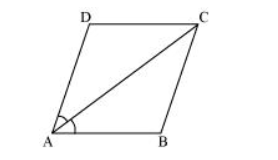Diagonal AC of a parallelogram ABCD bisects ∠A (see the given figure). Show that<br/><br/>(i) It bisects $\angle \mathrm{C}$ also,<br/><br/>(ii) $A B C D$ is a rhombus.

Solution:
(i) $A B C D$ is a parallelogram.
$\therefore \angle \mathrm{DAC}=\angle \mathrm{BCA}$ (Alternate interior angles) $\ldots$ (1)
And, $\angle B A C=\angle D C A$ (Alternate interior angles) $\ldots$ (2)
However, it is given that $A C$ bisects $\angle A$.
$\therefore \angle \mathrm{DAC}=\angle \mathrm{BAC} \ldots(3)$
From equations $(1),(2)$, and $(3)$, we obtain
$\angle \mathrm{DAC}=\angle \mathrm{BCA}=\angle \mathrm{BAC}=\angle \mathrm{DCA} \ldots(4)$
$\Rightarrow \angle \mathrm{DCA}=\angle \mathrm{BCA}$
Hence, $\mathrm{AC}$ bisects $\angle \mathrm{C}$.
(ii)From equation (4), we obtain
$\angle D A C=\angle D C A$
$\therefore \mathrm{DA}=\mathrm{DC}$ (Side opposite to equal angles are equal)
However, $D A=B C$ and $A B=C D$ (Opposite sides of a parallelogram)
$\therefore \mathrm{AB}=\mathrm{BC}=\mathrm{CD}=\mathrm{DA}$
Hence, $A B C D$ is a rhombus.
Click here to get exam-ready with eSaral
For making your preparation journey smoother of JEE, NEET and Class 8 to 10, grab our app now.
